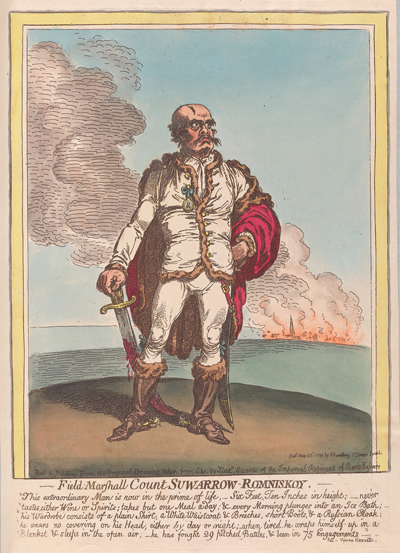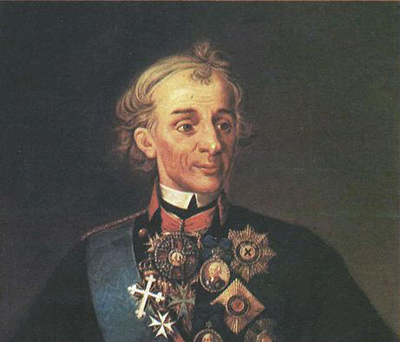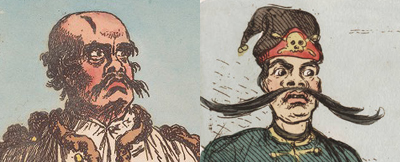Field-Marshall Count Suwarrow-Romniskoy
In the late 18th century, as now, there was a thirst to see images of celebrities made famous in the pages of the popular London newspapers. And part of Gillray's job as a graphic artist was to provide credible images of those celebrities in Hannah Humphrey's printshop window.

© Beinecke Rare Book and Manuscript Library, Yale University
Field-Marshall Count Suwarrow-Romniskoy was already well known in England as the principal nemesis of England's ally, the Ottoman Turks, having scored numerous victories over the Turks during the Russo-Turkish Wars of 1787–1792. But by 1798, Russia had joined England and Austria in the War of the Second Coalition against France to counter the growing aggression of the revolutionary Directorate. One of Catherine the Great's most experienced and trusted generals, Suwarrow had fallen out of favor with her son and successor, the Tsar Paul. But in April of 1799 Suwarrow was reinstated as Field Marshall at the request of Austria to help recover the territory in Italy and Switzerland that had been lost to Napoleon. And in May, at the time of this print, he was fresh from the first of a string of Italian victories at Cassano.
Like many of Gillray's full-length portraits of military leaders, Suwarrow is seen from slightly below poised on an eminence with his recent conquest consumed in flames in the distance. In this case, he leans on a sword still bloody from battle with a prominent scar upon his balding head, looking as formidable as a military leader should.
If time and marketplace funding allowed, celebrity images, like this one, were produced as carefully executed portraits such as Gillray's Marquis la Fayette (1781), The Prince of Saxe-Coburg (1794), General Count Clairfay (1794), and Sir Sydney Smith (1799). In other cases, Gillray quickly sketched likenesses, based upon observation such as A Man of Importance (1799) or upon other more formal portraits available to him like The Grand Sultan (1794) or [Tomb of Sir George Savile] (1799). In general, Gillray prided himself on creating authentic and recognizable caricature portraits of his subjects. But accuracy, though important, was not the only factor. Currency—the ability to provide an image at the moment when interest was at its peak— could, and sometimes did eclipse accuracy. In The Rights of Man. . . (1791), for instance, Gillray created a "Tommy Paine" who looks nothing like Thomas Paine in order to take advantage of the notoriety of the recently expanded Rights of Man. It was not for another couple of years that Gillray finally provided a real likeness of Paine in Fashion Before Ease. . . (1793)
In the case of Field-Marshall Count Suwarrow-Romniskoy, Gillray seems to have been much more interested in creating a timely and striking image than an accurate one. For although the publication line creates an air of authenticity by asserting that the print is etched by Gillray "from the Original Drawing taken from Life by Lieutn Swarts, of the Imperial Regiment of Barco Hussars, the claim, as the British Museum commentary notes, is patently false. Gillray's portrait is nothing like existing prints and paintings of the "real" Suwarrow.

© Wiki Quotes: Public Domain
On the contrary, Gillray's Field Marshall is much more like the generic Prussian hussar he created in The Introduction (1791).

© Beinecke Rare Book and Manuscript Library, and
Lewis Walpole Library, Yale University
The print includes the following note as a caption:
This extraordinary Man is now in the prime of life, - Six Feet, Ten Inches in height; - never \ "tastes either Wine or Spirits; takes but one Meal a day; " & every Morning plunges into an Ice Bath; - \ "his Wardrobe consists of a plain Shirt, a White Waistcoat & Breeches, short Boots, & a Russian Cloak; \ "he wears no covering on his head either by day or night - when tired, he wraps himself up in \ "a Blanket & sleeps in the open air; - he has fought 29 pitched Battles, & been in 75 Engagements" - See Vienna Gazzette.'
The caption is ostensibly sourced from the Vienna Gazette, a publication of the Austrian court. And since Russian and Austrian troops were working together (under Suwarrow), English newspapers relied upon the Gazette as at least one of their sources of information about the Russian-Austrian counteroffensive against France in Italy.
But just as the claim that the image is based on an "Original Drawing taken from Life" the attribution of the caption to the Vienna Gazette, though plausible, is almost certainly false. A more likely source is Lloyd's Evening Post which included the following note on May 1st, three weeks before Gillray's print appeared.
The following anecdotes are related in the French Papers of General Suwarrow. . . At Hazof, where there was a Hungarian Regiment, he assembled the Officers [and after drinking] the health of the Emperor, his Master. . . went into an ice bath, which was always prepared before he arrived at any place. His wardrobe consists of a short white waistcoat, a pair of white breeches, short boots, and a cloak; he has neither uniform nor any military dress whatever, and keeps his head, which is bald, uncovered, even during the time he is travelling.
Apart from lending a veneer of plausibility for some people, the attribution of the print's caption to the Vienna Gazette may have had an additional ironic dimension for Gillray and others who were better informed. As an organ of the government, the Vienna Gazette routinely exaggerated Austrian victories and minimized or completely overlooked Austrian defeats. So although it was referenced and used by the English press, any reports from the Gazette had to be regarded with some suspicion.
Gillray was clearly aware of the fictional image he was creating, and he must certainly have known Suwarrow was neither as tall nor as young as his caption claimed (Suwarrow was 68). But by attributing the caption to the unreliable Vienna Gazette, he could relieve himself of responsibility for the exaggerations and laugh at them at the same time.
Sources and Reading
- Commentary from the British Museum on Field-Marshall Count Suwarrow-Romniskoy.
- "Alexander Suvorov," Wikipedia
- "Italian and Swiss expedition," Wikipedia
- "War of the Second Coalition," Wikipedia
- "Campaigns of 1799 in the French Revolutionary Wars," Wikipedia
- Thomas Wright and R.H. Evans, Historical and Descriptive Account of the Caricatures of James Gillray #240
- Thomas Wright and Joseph Grego, The Works of James Gillray, the Caricaturist; With the History of His Life and Times p. 259.
Comments & Corrections
NOTE: Comments and/or corrections are always appreciated. To make that easier, I have included a form below that you can use. I promise never to share any of the info provided without your express permission.